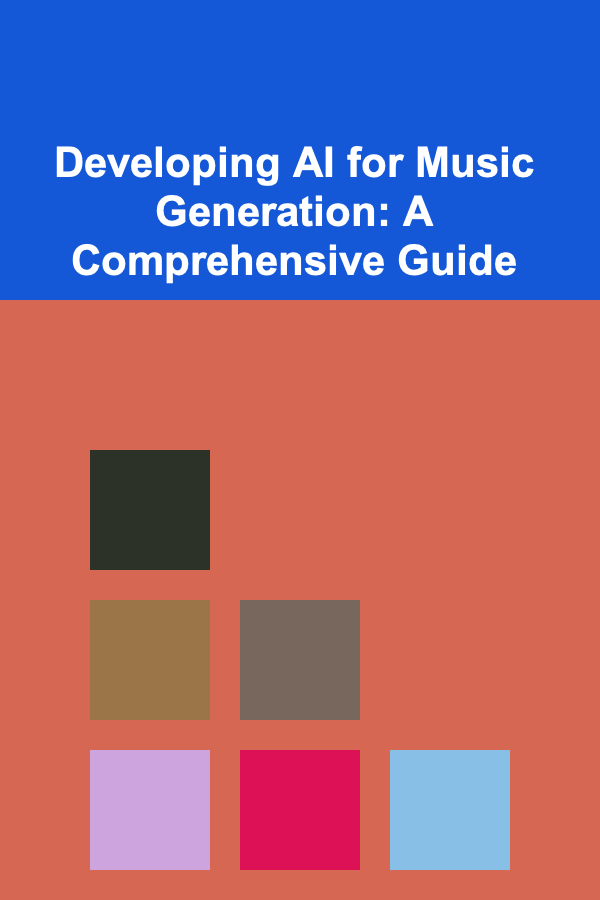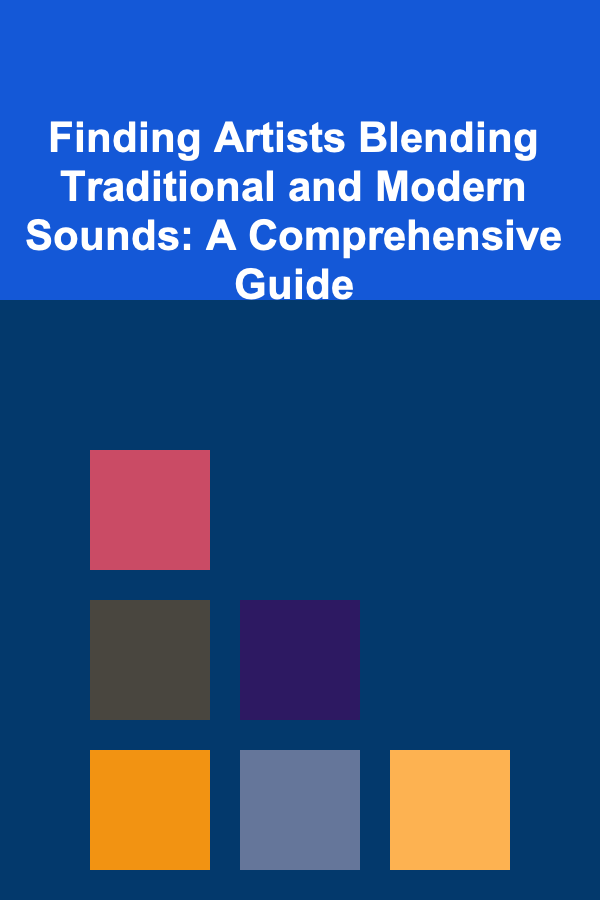
Developing AI for Music Generation: A Comprehensive Guide
ebook include PDF & Audio bundle (Micro Guide)
$12.99$8.99
Limited Time Offer! Order within the next:

Artificial intelligence (AI) has revolutionized numerous fields, and music is no exception. AI-driven music generation is rapidly evolving, offering exciting possibilities for composers, musicians, and music enthusiasts alike. Developing robust and creative AI for music generation is a complex endeavor requiring a blend of technical expertise, musical understanding, and artistic vision. This article delves into the intricacies of creating such AI, covering various aspects from fundamental concepts to advanced techniques and future directions.
I. Foundational Concepts: Music and Machine Learning
Before diving into specific AI models, it's crucial to understand the underlying concepts in both music and machine learning.
A. Musical Representation
The first step is to determine how music will be represented digitally. Several options exist, each with its own advantages and disadvantages:
- MIDI (Musical Instrument Digital Interface): A symbolic representation that encodes musical information such as notes, pitch, duration, velocity, and instrument assignments. It's easily manipulated and understood by computers, making it suitable for many AI applications. However, it lacks the nuances of real-world performance, such as timbre variations and subtle expressive techniques.
- Audio Waveforms: Represent music as a series of amplitude values over time. This provides the most realistic and detailed representation but can be computationally expensive to process. Analyzing and generating raw audio requires sophisticated techniques.
- Symbolic Music Notation (e.g., MusicXML): A more complex symbolic representation that captures the structure of a musical score, including notes, chords, time signatures, key signatures, and other musical markings. It's useful for generating complete scores but requires parsing and understanding complex musical rules.
- Piano Roll Representation: A visual representation of music where time is on the horizontal axis and pitch is on the vertical axis, with rectangles indicating the presence and duration of notes. This is commonly used in machine learning due to its simplicity and ease of manipulation.
The choice of representation depends on the specific goals of the AI system. For example, if the goal is to generate realistic audio, waveform representation is necessary. If the goal is to generate sheet music, symbolic notation is more appropriate.
B. Machine Learning Fundamentals
A solid understanding of machine learning principles is essential for building effective music generation AI. Key concepts include:
- Supervised Learning: Training a model on labeled data, where the input is a piece of music and the output is the desired style, genre, or continuation. This requires a large dataset of music with corresponding labels.
- Unsupervised Learning: Training a model on unlabeled data to discover patterns and structures within the music. This can be used for tasks like clustering music into different styles or learning the underlying statistical properties of a musical genre.
- Reinforcement Learning: Training an agent to interact with an environment and learn to generate music based on a reward signal. This can be used to create AI that can improvise or compose music in real-time.
- Deep Learning: A type of machine learning that uses artificial neural networks with multiple layers to learn complex patterns from data. Deep learning has become increasingly popular in music generation due to its ability to model intricate musical structures. Recurrent Neural Networks (RNNs), Transformers, and Variational Autoencoders (VAEs) are particularly relevant.
II. AI Models for Music Generation
Several AI models have proven effective for music generation. Here, we explore some of the most prominent ones:
A. Recurrent Neural Networks (RNNs)
RNNs are well-suited for processing sequential data like music because they maintain a "memory" of past inputs. This allows them to capture the temporal dependencies inherent in music, such as melody, harmony, and rhythm.
- LSTM (Long Short-Term Memory): A type of RNN that addresses the vanishing gradient problem, allowing it to learn long-range dependencies more effectively. LSTMs are widely used for music generation because they can remember musical patterns over extended periods.
- GRU (Gated Recurrent Unit): A simplified version of LSTM with fewer parameters, making it computationally more efficient. GRUs can often achieve similar performance to LSTMs while requiring less training data and processing power.
Implementation Considerations:
- Data Preprocessing: Convert musical data (e.g., MIDI) into a sequence of tokens. These tokens can represent individual notes, chords, rests, or other musical elements.
- Model Architecture: Design an RNN with multiple LSTM or GRU layers. The number of layers and the size of each layer (number of hidden units) are important hyperparameters to tune.
- Training: Train the RNN on a large dataset of music. The goal is for the RNN to learn the probability distribution of the next token given the preceding tokens. Common loss functions include categorical cross-entropy.
- Generation: Once trained, the RNN can generate new music by repeatedly predicting the next token and feeding it back into the model. Techniques like temperature sampling can be used to control the randomness of the generation.
Example (Conceptual):
# Python (Conceptual - using PyTorch/TensorFlow assumed)
import torch
import torch.nn as nn
class MusicRNN(nn.Module):
def __init__(self, input_size, hidden_size, output_size, num_layers=2):
super(MusicRNN, self).__init__()
self.hidden_size = hidden_size
self.num_layers = num_layers
self.embedding = nn.Embedding(input_size, hidden_size) # Convert tokens to embeddings
self.lstm = nn.LSTM(hidden_size, hidden_size, num_layers, batch_first=True)
self.fc = nn.Linear(hidden_size, output_size)
def forward(self, input, hidden):
embedded = self.embedding(input)
output, hidden = self.lstm(embedded, hidden)
output = self.fc(output)
return output, hidden
def init_hidden(self, batch_size):
return (torch.zeros(self.num_layers, batch_size, self.hidden_size),
torch.zeros(self.num_layers, batch_size, self.hidden_size))
This code snippet provides a basic outline of an RNN for music generation. It includes an embedding layer to convert musical tokens into vector representations, an LSTM layer to process the sequence, and a fully connected layer to predict the next token. The forward function describes how the input is processed through the network, and the init_hidden function initializes the hidden state of the LSTM.
B. Transformers
Transformers, initially developed for natural language processing (NLP), have recently gained popularity in music generation due to their ability to model long-range dependencies more effectively than RNNs. Transformers rely on the attention mechanism, which allows the model to focus on the most relevant parts of the input sequence when making predictions.
- Advantages: Parallel processing of the input sequence, allowing for faster training and generation. Superior ability to capture long-range dependencies compared to RNNs.
- Disadvantages: More complex architecture than RNNs, requiring more computational resources. Can be challenging to train on smaller datasets.
Implementation Considerations:
- Tokenization: Similar to RNNs, music must be tokenized into a sequence of discrete units. Byte Pair Encoding (BPE) or WordPiece tokenization, commonly used in NLP, can be adapted for music.
- Architecture: Use a transformer architecture with multiple encoder and decoder layers. The attention mechanism is the core component of the transformer.
- Training: Train the transformer using a masked language modeling objective, where the model is trained to predict masked tokens in the input sequence.
- Generation: Generate music by iteratively predicting the next token, similar to RNNs.
Example (Conceptual):
# Python (Conceptual - using PyTorch/TensorFlow assumed)
import torch
import torch.nn as nn
from transformers import AutoModelForCausalLM, AutoTokenizer
# Example using a pre-trained language model (fine-tuning approach)
model_name = "distilgpt2" # Example pre-trained model
tokenizer = AutoTokenizer.from_pretrained(model_name)
model = AutoModelForCausalLM.from_pretrained(model_name)
# Assuming 'musical_data' is a sequence of tokens representing your music
# Convert the sequence to the correct format (token IDs)
input_ids = tokenizer.encode(musical_data, return_tensors="pt")
# Generate music
output = model.generate(input_ids, max_length=100) # Generate 100 tokens
generated_music = tokenizer.decode(output[0], skip_special_tokens=True)
print(generated_music)
This example leverages a pre-trained language model (DistilGPT-2) from the Hugging Face Transformers library. The music is first tokenized using the tokenizer associated with the pre-trained model. Then, the generate function is used to generate new music based on the input sequence. This approach allows you to leverage the knowledge encoded in a large pre-trained model and fine-tune it for music generation.
C. Variational Autoencoders (VAEs)
VAEs are generative models that learn a latent space representation of the input data. This latent space captures the underlying structure and relationships within the data, allowing for the generation of new data points that are similar to the training data. In the context of music, VAEs can be used to learn a latent space of musical styles, genres, or even entire songs.
- Encoder: Maps the input music to a latent space representation (typically a Gaussian distribution).
- Decoder: Reconstructs the original music from the latent space representation.
- Advantages: Can generate diverse and coherent music by sampling from the latent space. Allows for interpolation between different musical styles or genres.
- Disadvantages: Can be difficult to train, requiring careful tuning of hyperparameters. The generated music may sometimes lack the structure and coherence of real music.
Implementation Considerations:
- Data Preprocessing: Convert music into a suitable representation (e.g., piano roll).
- Architecture: Design an encoder and decoder network. The encoder typically consists of convolutional or recurrent layers, while the decoder consists of deconvolutional or recurrent layers.
- Training: Train the VAE using a combination of reconstruction loss (to ensure the decoder can accurately reconstruct the input music) and a Kullback-Leibler (KL) divergence loss (to ensure the latent space is well-behaved).
- Generation: Generate new music by sampling from the latent space and decoding the sampled vector.
Example (Conceptual):
# Python (Conceptual - using PyTorch/TensorFlow assumed)
import torch
import torch.nn as nn
class MusicVAE(nn.Module):
def __init__(self, input_dim, latent_dim):
super(MusicVAE, self).__init__()
self.encoder = nn.Sequential(
nn.Linear(input_dim, 256),
nn.ReLU(),
nn.Linear(256, 128),
nn.ReLU(),
nn.Linear(128, latent_dim * 2) # Output mean and log variance
)
self.decoder = nn.Sequential(
nn.Linear(latent_dim, 128),
nn.ReLU(),
nn.Linear(128, 256),
nn.ReLU(),
nn.Linear(256, input_dim),
nn.Sigmoid() # Ensure output is between 0 and 1 (if using piano roll)
)
self.latent_dim = latent_dim
def encode(self, x):
mu_logvar = self.encoder(x)
mu = mu_logvar[:, :self.latent_dim]
logvar = mu_logvar[:, self.latent_dim:]
return mu, logvar
def reparameterize(self, mu, logvar):
std = torch.exp(0.5 * logvar)
eps = torch.randn_like(std)
return mu + eps * std
def decode(self, z):
return self.decoder(z)
def forward(self, x):
mu, logvar = self.encode(x)
z = self.reparameterize(mu, logvar)
x_recon = self.decode(z)
return x_recon, mu, logvar
This code defines a basic VAE architecture for music generation. The encoder maps the input music (represented as a vector) to a latent space, and the decoder reconstructs the music from the latent space. The reparameterize function introduces randomness into the latent space, allowing for the generation of diverse music samples.
D. Generative Adversarial Networks (GANs)
GANs consist of two neural networks: a generator and a discriminator. The generator tries to create realistic music samples, while the discriminator tries to distinguish between real music samples and generated samples. The generator and discriminator are trained adversarially, with the generator trying to fool the discriminator and the discriminator trying to correctly identify the fake samples. This adversarial training process can lead to the generation of highly realistic and compelling music.
- Generator: Generates music samples from random noise.
- Discriminator: Distinguishes between real music samples and generated samples.
- Advantages: Can generate highly realistic and compelling music.
- Disadvantages: Difficult to train, requiring careful tuning of hyperparameters. Prone to mode collapse, where the generator only produces a limited variety of music samples.
Implementation Considerations:
- Data Preprocessing: Convert music into a suitable representation (e.g., waveforms, spectrograms).
- Architecture: Design a generator and discriminator network. The generator typically consists of deconvolutional or recurrent layers, while the discriminator typically consists of convolutional or recurrent layers.
- Training: Train the generator and discriminator adversarially. Use techniques like batch normalization and spectral normalization to stabilize training.
- Generation: Generate new music by feeding random noise into the generator.
Example (Conceptual):
# Python (Conceptual - using PyTorch/TensorFlow assumed)
import torch
import torch.nn as nn
# Simplified example - Generator
class Generator(nn.Module):
def __init__(self, latent_dim, output_dim):
super(Generator, self).__init__()
self.model = nn.Sequential(
nn.Linear(latent_dim, 256),
nn.ReLU(),
nn.Linear(256, output_dim),
nn.Tanh() # Output should be in a range suitable for your music representation
)
def forward(self, z):
return self.model(z)
# Simplified example - Discriminator
class Discriminator(nn.Module):
def __init__(self, input_dim):
super(Discriminator, self).__init__()
self.model = nn.Sequential(
nn.Linear(input_dim, 256),
nn.ReLU(),
nn.Linear(256, 1),
nn.Sigmoid() # Output probability of being real
)
def forward(self, x):
return self.model(x)
This code provides a simplified example of a GAN for music generation. The generator takes random noise as input and outputs a music sample. The discriminator takes a music sample (either real or generated) as input and outputs a probability indicating whether the sample is real. These two networks are trained adversarially, with the generator trying to fool the discriminator and the discriminator trying to correctly identify the fake samples.
III. Advanced Techniques and Considerations
Beyond the basic models, several advanced techniques can enhance the quality and creativity of AI-generated music:
A. Conditional Generation
Conditional generation allows you to control the characteristics of the generated music by providing additional input to the model. This input can be a specific genre, style, instrument, mood, or even a melody.
- Implementation: Incorporate the conditioning information into the model as additional input features. For example, you could add a one-hot vector representing the genre to the input of an RNN or VAE.
- Benefits: Allows for greater control over the generated music. Enables the creation of music in specific styles or genres.
B. Hierarchical Models
Hierarchical models generate music at multiple levels of abstraction. For example, a hierarchical model might first generate the overall structure of a song (e.g., verse-chorus-verse) and then generate the individual melodies and harmonies within each section.
- Implementation: Use a multi-level architecture with separate models for generating different aspects of the music.
- Benefits: Can generate music with more complex and coherent structures.
C. Incorporating Musical Theory
Integrating musical theory concepts (e.g., harmony, counterpoint, voice leading) into the AI model can improve the musicality of the generated music.
- Implementation: Design loss functions that penalize violations of musical rules. Use knowledge-based systems to filter or modify the generated music to ensure it adheres to musical principles.
- Benefits: Can generate music that is more pleasing to the ear and adheres to established musical conventions.
D. Addressing Common Challenges
Several challenges are commonly encountered when developing AI for music generation:
- Lack of Coherence: Generated music may lack overall structure and coherence. Hierarchical models and long-range dependencies in Transformers help mitigate this.
- Repetitiveness: The AI may generate repetitive patterns. Using techniques like temperature sampling and stochastic sampling can introduce more randomness into the generation process.
- Blandness: The generated music may lack originality and expressiveness. Training on diverse datasets and using adversarial training can help improve the creativity of the AI.
- Computational Cost: Training complex models can be computationally expensive. Utilize GPUs or cloud-based resources to accelerate training. Consider model compression techniques for efficient deployment.
IV. Evaluation Metrics
Evaluating the quality of AI-generated music is a challenging task. Subjective evaluation by human listeners is often necessary, but it's also helpful to use objective metrics to assess different aspects of the music.
- Musicality: Evaluate the adherence to musical rules and conventions (e.g., harmony, voice leading).
- Coherence: Assess the overall structure and flow of the music.
- Originality: Determine the novelty and uniqueness of the generated music.
- Realism: Evaluate how closely the generated music resembles real-world music.
- User Preference: Gather feedback from human listeners to assess their enjoyment of the generated music. Metrics like Mean Opinion Score (MOS) are common.
Automated metrics are also being developed, but they often struggle to capture the subjective qualities of music. Some examples include:
- Note Density: Measures the average number of notes per unit of time.
- Pitch Range: Measures the range of pitches used in the music.
- Rhythmic Complexity: Measures the diversity and complexity of the rhythmic patterns.
V. Future Directions
The field of AI-driven music generation is rapidly evolving, with many exciting avenues for future research and development:
- Improved Models: Development of more sophisticated AI models that can capture the nuances of musical expression and generate more realistic and compelling music. Exploring hybrid approaches that combine different AI models (e.g., RNNs and Transformers).
- Interactive Music Generation: Creation of AI systems that can interact with human musicians in real-time, allowing for collaborative music creation.
- Personalized Music Generation: Development of AI systems that can generate music tailored to the individual preferences of listeners.
- Ethical Considerations: Addressing the ethical implications of AI-generated music, such as copyright issues and the potential displacement of human musicians.
- Cross-Modal Integration: Combining music generation with other modalities, such as images or text, to create richer and more immersive experiences. For instance, generating music based on the content of an image or a story.
- Explainable AI (XAI): Developing AI models that can explain their musical choices, allowing users to understand the reasoning behind the generated music. This could be invaluable for music education and composition.
VI. Conclusion
Developing AI for music generation is a challenging but rewarding endeavor. By understanding the fundamental concepts of music and machine learning, and by carefully selecting and implementing appropriate AI models, it's possible to create systems that can generate compelling and creative music. The field is constantly evolving, and the future holds exciting possibilities for AI-driven music creation. The keys to success are a strong foundation in both music theory and machine learning, a willingness to experiment with different approaches, and a commitment to addressing the ethical implications of this rapidly advancing technology.

How to Manage Pet Separation Anxiety at Home
Read More
How to Sell Vintage Watches on Instagram: An Actionable Guide
Read More
How to Discover Novels That Are Perfect for Escaping Reality
Read More
Finding Artists Blending Traditional and Modern Sounds: A Comprehensive Guide
Read More
How to Fuel Your Workouts with Healthy Food
Read More
How to Use Spreadsheets to Track Child Support and Alimony
Read MoreOther Products

How to Manage Pet Separation Anxiety at Home
Read More
How to Sell Vintage Watches on Instagram: An Actionable Guide
Read More
How to Discover Novels That Are Perfect for Escaping Reality
Read More
Finding Artists Blending Traditional and Modern Sounds: A Comprehensive Guide
Read More
How to Fuel Your Workouts with Healthy Food
Read More